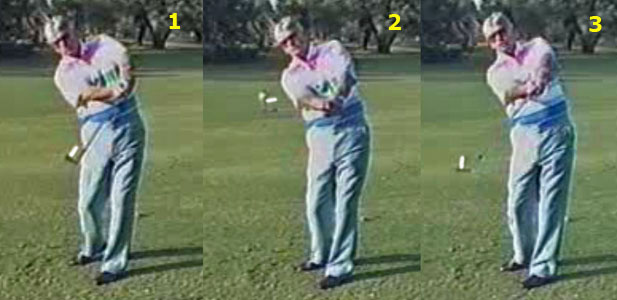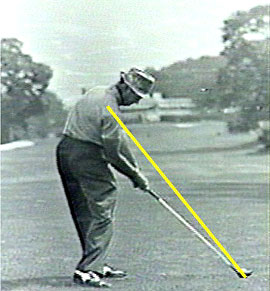
After my club championship, one of the things I discussed that I needed to improve was distance. In the summertime, my drives probably averaged around 280 yards and I hit my 8-iron about 155 yards long. However, one of my main goals for next year is to add about 25 yards with my driver and an extra club with my irons.
While it's vital for me to at least maintain my accuracy while adding distance, I think the extra distance could make for a much improved scoring average as I would likely increase my GIR percentage along with my chances of going for par-5's in two, both of which correlate to lower stroke averages. Furthermore, it will increase my chances to get a wedge in my hand and with full swings I'm usually pretty precise with anything from a 9-iron or less.
But how does one accomplish that without losing accuracy?
While I will discuss this more with my instructor Ted Fort, here's some of the ideas I had for a plan to achieve my power goals.
STEP 1 - WEIGHT LOSS
After the operation I wound up gaining 30 pounds due to having to take 6 months from working out and well, general laziness. However, I plan on losing that 30 pounds which usually has never been much of a problem for me since I have a fast metabolism.
I think this can help improve one's pivot which I strong feel adds to power and more precise ballstriking. However, the bigger reason for the weight loss in regards to golf is that the upcoming tournaments will be ones where the golfers have to walk the course and I'll have to increase my stamina for that so I can finish the final holes of a tournament stronger.
STEP 2 - INCREASE FLEXIBILITY
I will be working with Roger Fredericks' golf stretching exercise program. I worked with it before and liked it a lot. Very simple and effective, but quit doing the program. Yoga classes are a good idea as well, but they start to get a bit expensive and time consuming. While I believe that stretching can help the pivot which can help with power and more precise ballstriking, I also think it's a good idea for overall health and golf longevity as no other sport, IMO, requires the total flexibility like golf.
Here's a video of Fredericks demonstrating some of his stretching program:
STEP 3 - KNOWING WHERE YOU ARE SO YOU CAN GET TO WHERE YOU WANT TO BE
One of the clever quotes from Jim McLean's 'The Eight Step Golf Swing' talks about the golfer and the teacher being able to communicate with each other and McLean compares it to giving somebody automobile driving directions. In essence, McLean stated that in order to give directions you need to know where the person is coming from so you can tell them what streets to take.
The same applies with golf and I believe the same applies here. I estimate that in order to reach my power goals, I will need to increase my clubhead speed on average by at least 8 mph. But first, I need to know what the clubhead speed is with each club and I plan on using the doppler radar technology behind the Swing Speed Radar

The Swing Speed Radar can be purchased for $99.
STEP 4 - USING THE ENDLESS BELT EFFECT (2-K) TO MY ADVANTAGE
I discussed Homer Kelley's 'Endless Belt Effect' in this TGM Translation Post.
I'm not exactly sure Physicist Dr. Robert Grober of Sonic Golf would agree completely with the Endless Belt Effect, but I think he would believe that the idea wasn't too far off in comparison to his research.
The Endless Belt Effect states a couple of things. One is that the hands on the downswing move at the same speed thru the downswing, but the clubhead will accelerate in the downswing.
So, if I were going to give an arbitrary number of say the hands moving from the top of the swing to about one foot downward of say 50 mph, then according to the Endless Belt Effect, the hands *should* move at 50 mph from that one foot downward to impact. However, the clubhead may reach impact at say 100 mph, but in the startdown it may move at say 50 mph, then accelerate to 75 mph when the clubshaft is parallel to the ground, then accelerate to 100 mph at impact. Again, those numbers are arbitrary, just trying to make the Endless Belt Effect easier to understand.
The other part is the 'size of the pulley' and it in regards to clubhead speed. The pulley size has a lot to do with the delivery path of the hands and the 'snap' of the release and how somebody 'maximizes trigger delay.'
Jeff Mann did a very nice job of describing Endless Belt Effect over at his Perfect Golf Swing Review Web site.
The best way I can describe it is the more the golfer delays the trigger of the downswing (aka maximum trigger delay) the 'smaller their pulley' will be. The smaller their pulley, the more clubhead speed they can achieve despite having a SLOWER hand speed.
So let's say you have two golfers whose clubhead speed is say about 110 mph with a driver. But golfer A really maximizes that 'trigger delay' and has that very small pulley while golfer B doesn't maximize that trigger delay and has a large pulley.
Even though they both have the same amount of clubhead speed, Golfer A can achieve it with SLOWER handspeed than Golfer B.
So, if Ben Hogan (maximum trigger delay, snap release, small pulley) and Tom Watson (no maximum trigger delay, full sweep release, large pulley) were to swing the clubhead at 110 mph, then Mr. Hogan could do it with say a hand speed of 50 mph while Mr. Watson would have to do with a faster hand speed, say 75 mph.
That doesn't mean you HAVE to maximize your trigger delay and make your pulley smaller to hit it farther, it means that you EITHER have to maximize your trigger delay or increase your hand speed. I plan on doing a little of both for the full effect. But if I kept my same hand speed and maximized my trigger delay, that would increase distance as well.
STEP 5 - TRACKMAN WORK
I think Trackman is a wonderful tool for helping with the golf swing, but I think it's best work is done with the driver because it can help add a ton of distance along with increasing accuracy. The big part Trackman has gotten into is shallowing out the angle of attack with the driver, even to the point of promoting an upward hit with the driver to increase distance. A golfer can greatly increase yardage by taking the same swing and just changing their angle of attack. And according to Trackman, downward hits with the driver cause the 'Smash Factor' (ball speed / clubhead speed) to decrease.
In their July 2009 Newsletter Trackman studied the case of Kevin Streelman who used Trackman to greatly increase his power off the tee.
In roughly 12 months from using Trackman, Streelman changed his Angle of Attack with his driver from a -5.6* angle of attack to a -1.0* angle of attack. Despite still hitting down on the ball, that decrease in the angle of attack caused him to increase his carry by 23 yards (an 8.6% increase in carry alone).
Furthermore, his clubhead speed went down by 2 mph in this time, but his ballspeed went UP by 4 mph. That changed his smash factor from 1.43 to 1.49. Furthermore, his spin rate went from 2,887 rpm's to 2,399. So Streelman greatly increased his carry and increased his roll on top of it. Probably increasing his power in his driver by 25-35 yards on average.
He also wound up switching from a Cleveland Hi-Bore XLS Driver with 10.5* loft to the same clubhead with 8.5* loft and with a stiffer shaft (and still increased his carry by 23 yards and lowered his spin rate).
Amazing.
STEP 6 - EQUIPMENT CHANGES
Hopefully when I feel the changes to my swing are complete, I'll make some changes and tweaks to my equipment.
I will probably go to some KBS shafts in my irons and possibly my 3-hybrid. I will then probably change my driver and 3-wood. I'm interested in changing my lofts with these clubs as right now I carry a 10.5* driver with a 15* 3-wood. With my most recent swing changes, I can actually hit the driver very well off the deck. That sort of notes that I need a lower lofted driver already. I'm very interested in the Adams Golf line of drivers. Also, I believe with my ability to hit my current driver off the deck, I will probably need to go to a 13* 3-wood.
3JACK





















